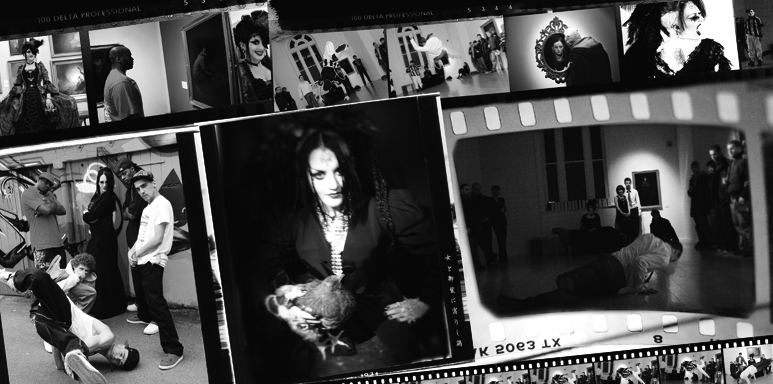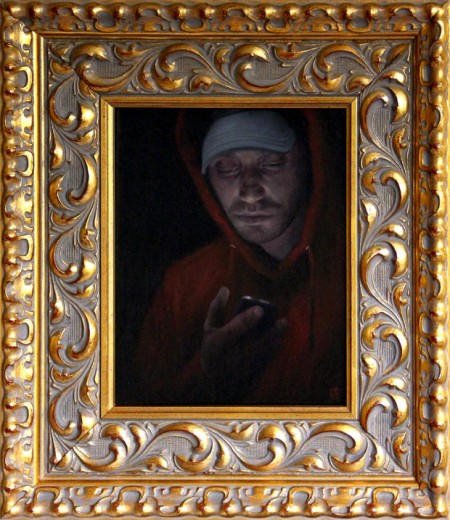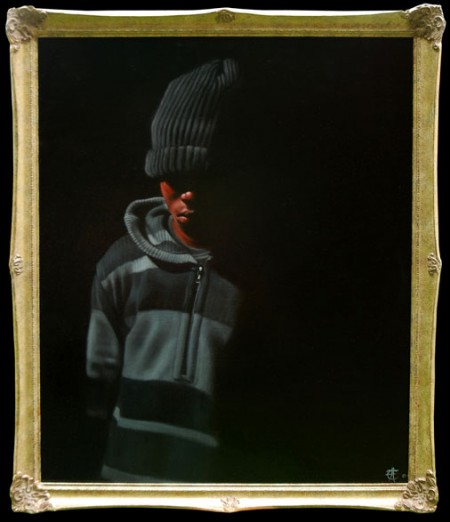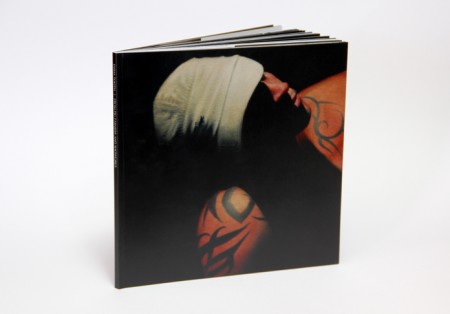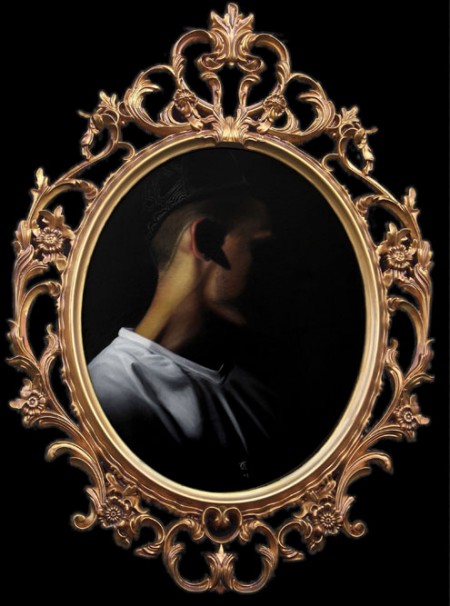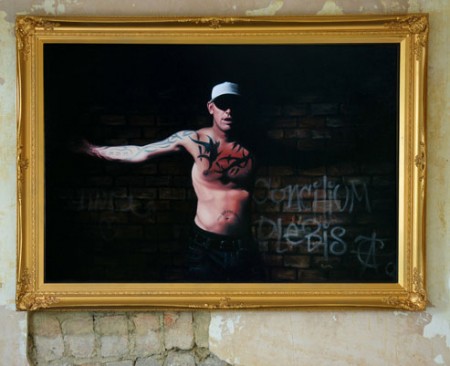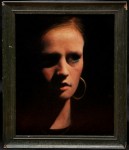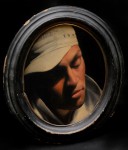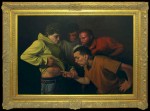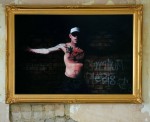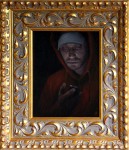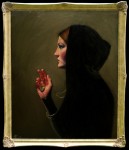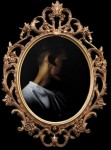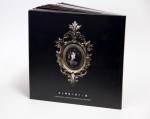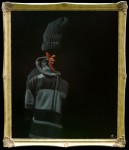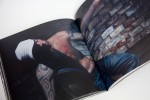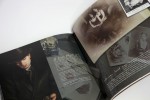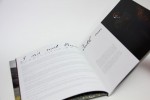Emma Tooth’s ‘Concilium Plebis’ series of oil paintings have been described as “Extraordinary portraits of ordinary people.” This week sees the Derbyshire based artist open her London solo show at the Lazarides’ Outsiders Gallery, as well as making her debut showing in the United States in Thinkspace’s five year anniversary show. AM caught up with Emma just ahead of the exhibition, which opens on Thursday 4th November, and put a few questions to the exciting young artist.
Check out our interview and some further preview images after the jump.
Arrested Motion (AM): We’ve known each other for a little while now, and I find you to be a fascinating person. For the benefit of AM’s readers could you give us a brief introduction to the world of Emma Tooth?
Emma Tooth (ET): I don’t think I can. Let’s hope they pick it up throughout the interview!
AM: Watching your technique of under-painting and over-layering is mesmerizing. From where did you develop the chiaroscuro style with which you paint?
ET: My painting style is completely self-developed. There was no one around who could teach me to paint in oils the way I wanted to so I had to just keep trying till I figured out a way that works for me. I’ve been at it something like 15 years now – I’ll get there eventually.
AM: We’ve seen your work in various galleries throughout the UK in recent years, but you have this latest showing of the ‘Concilium Plebis’ paintings at Lazarides’ Outsiders Gallery. How did the Lazarides connection come about?
ET: They just emailed me one day out of the blue and invited me. I asked them later how they found out about me and they said no one could remember – all very mysterious I say! I have to confess that, because I actually do live under the proverbial rock, I hadn’t heard of them before. I’m actually completely disconnected from the “art world” – and the world in general really.
AM: Where and when did the concept for the Concilium Plebis paintings originate? Tell us a little about what message you are hoping to find and convey with this body of work…
ET: Well, it was few years ago now; I was living in the centre of a city (not a very nice area), and I was unhappy there to say the least. Several galleries I was working with at the time had said to me they would like to give me solo shows if I came up with a cohesive body of work to present all together, instead of the disparate, individual portraits I was producing at the time. This was the next stage for me really, to think in terms of shows rather than just selling individual paintings here and there.
So I was wracking my brains trying to think where do I want to go next? I wanted it to have a social aspect to it, something people could relate to – but yet not part of the soulless, tasteless, trashy popular culture I so abhor! I had been through a period of painting myself a lot (it was good way to experiment, I gained a lot of self-awareness… and finding a model was always easy) and around this time my mother phoned me. We were chatting about all this and she said “you’ve painted enough pictures of yourself, why don’t you paint some normal people” or something like that! I tried to take it the right way – and soon enough the ideas for Concilium Plebis began to form – out of the desire to paint something of contemporary life but to infuse it with the beautiful art of the past which I can admire and relate to. It was a way for me to go outside and meet the world head on – to connect with things I’d never wanted to connect with – to filter the 21st Century through my own sensibilities and make it palatable to me.
AM: You received funding from The Arts Council in the past. Was this associated with the Concilium project?
ET: That’s correct. I received a small grant to start up the project and buy the gold frames and things.
AM: The different ways you’ve sourced the subjects and models for the paintings sounded interesting when we spoke about it before. You have a mixture of people you know, friends of friends through to people you’ve simply approached on the street. What makes a worthy subject for one of your paintings?
ET: A worthy subject! Well, one of the fun things about Concilum Plebis has been the serendipitous way I came across my models and images. I would go out as you said, and find models on the street, not knowing of course who I would find – if anyone – or how they would react. Sometimes I’d have a particular idea in mind of how their painting would look, but often not. The model would very much dictate – once I started working with them – the outcome of the picture.
A good example is the day there was an absolute blizzard and it was getting worse and worse and I just wanted to go home. In a moment of desperation, I spotted a guy going into McDonalds with his hood up against the snow. I really had no idea what he looked like because the visibility was terrible, and I’ve never seen weather like it since – and I thought right, it’s him or I’m going home! So when he came out again I cornered him in a shop doorway to shelter from the howling wind – it was terribly dramatic! – and asked him. He agreed right away and possibly said something about having modeled before but I honestly couldn’t understand him cause I think his face was numb with cold – but also because he had these gold grills on his teeth!
So we got back to my friend’s studio where I had already set up lights. Her studio was in the town and near enough to just whip people in and photograph them. We took the photographs which were later worked into Concilium Plebis 5, where he looked just as I found him in the street in the snow. I showed him some of my previous work and he was particularly interested in some of the tattoos I had painted. He then said “Do you like to paint tattoos? I have some.” Despite the cold, he took off his hooded jumpers and the result was Concilium Plebis numbers 4 and 7 – some of my very favourite pieces.
Another example was when I was working with the breakdance team Trinity Warriors – I set out with them to re-imagine Caravaggio’s “The Incredulity of Saint Thomas”, also popularly known as “Doubting Thomas” for my 10th painting in the series. I showed them the original in a book and let them just choose their places and fall into an approximation of the famous pose often described as four heads united in the quest for truth, or similar. As they are dancers, they were great to work with because they are confident, aware of themselves and each other. I remember saying, “I don’t suppose any of you has a real tattoo on his stomach?” And sure enough, the one already in the position of Jesus said “actually, I do!” – you couldn’t make it up – and sure enough, in just exactly the right position it read “Pride goes before a fall” – it even has a Biblical ring to it.
So the short answer to your question, I guess is – I don’t know, it just seems to happen!
AM: And I understand you photograph the models yourself to create the source imagery for your work?
ET: Absolutely. It’s essential, I think. It’s a big part of what I do. Firstly, if I didn’t create the images from the ground up I wouldn’t feel that they were truly mine or truly original – obviously though on this project I have borrowed some compositions from Caravaggio and Holbein, I admit!
I’m obsessed with lighting, it has to be right. I work with my husband, Owen, photographing the models. We have been together about 15 years so our work has grown together. We have always worked together and he is a filmmaker now, but still takes care of the technical aspects of all my photography. He’s brilliant. The main reason I work this way is because few people nowadays have the time to sit for weeks for me and pose – particularly if they’re in the middle of their shopping and I’ve just accosted them in the street – I may only have half an hour with them.
Then of course, once I have that photographic reference I can paint their portrait a year later, if I’m busy, or I can work on several portraits at once and I don’t have the pressure of a person in my studio, posing like Christ on the cross or something, complaining that his arms ache! I couldn’t work like that. I even hated having the cameras over my shoulder to film me painting for my documentary!
AM: For me, one of the most interesting things about AM is getting to visit artists in their studios to see the spaces they work within. When I visited your studio earlier this year, I was kind of surprised that you had a huge collection of religious iconography in the space. Where does your fascination with this particular kind of kitsch come from?
ET: Why were you so surprised, Sven? Elaborate!
AM: I guess I’m judging the proverbial book by it’s cover, but you don’t strike me as being one of the “devout,” shall we say…
ET: Hahaha! No, you’re right! But, I have always loved that stuff. Even the really awful stuff has a kind of beauty – even the pictures of Mother Mary with the flashing LEDs were made to evoke feelings of piety and awe just like a breathtaking cathedral, or indeed Caravaggio’s Doubting Thomas, presumably.
I went to a Church of England school, though my family were not at all religious, and so spent most of my childhood learning hymns. I know them all! And when it was “play time,” I would try to avoid going out to play hopscotch or whatever awful thing with the children (I did not feel I was one of them at all!) by cornering my teachers behind their acoustic guitars and having theological discussions with them. I’d ask in hushed tones, “you don’t actually believe all this stuff do you?” I was concerned that the people who were supposed to be older and wiser than me could believe such nonsense and pass it on to unsuspecting children. I could only have been 6 years old. I must have been a nightmare. I suppose it was there I lost the fear of religious objects, you could say.
AM: On the subject of your working environment, I understand that you lock yourself away from interactions when you are working – like a self imposed exile. Does this social withdrawal help your focus when creating work?
ET: Hahaha it’s not just when I’m working! I suppose I’m not what you’d call a people person! I’m really happy where I am now in the country and there’s just not a lot going on that I want to be involved in or that I could feel involved in. And I’d hate to spoil my frock!
AM: I know that you’ve been busy over the last few months putting together your DVD together with Owen and also your book, which are both due to be released to coincide with this show. Have these been interesting projects to work on for you? What formats do the DVD and the book follow?
ET: Incredibly busy. As well as the book and DVD, I’ve also obviously been making the paintings for the shows too. I ended up doing the whole book myself – one reason being that it was just too complicated to explain to someone else and too personal. I had a lot of ideas for the book that I had been playing with for several years and really only I could do it. It was a hell of a learning curve.
It’s been interesting looking at my work – and at myself – from the outside, thinking what would be interesting to an outsider, what would someone want to know about me? With the book I wanted to offer almost a peek inside my head rather than just a catalogue of works. I wanted to share what interests, inspires or influences me alongside what I produce. So it’s like a scrapbook, or rather, a musty old trunk that’s been in an attic for 80 years – you can open it up and peek inside, and try to piece things together from what you find inside.
Owen has done an amazing job on my DVD. His films are always very finely crafted – he’s an artist in his own right. On the DVD, you get the documentary film, the trailer of which has been up on my site for quite a while now, but you also get (insert shameless plug here) a behind-the-scenes video following the process of making a painting, photographing the models, and time-lapse footage of the painting as it grows – which I think is interesting for people, getting to “look over the artist’s shoulder” as it were. There are promos and slideshows, a full-length breakdance performance by Bad Taste Cru which took place at one of my shows in Newcastle and we have also included two of Owen’s own short films which I collaborated on with him and even appeared in!
It’s been an exhausting but good year.
AM: We last met at your Museum show in Derby where your paintings were displayed alongside those of the 18th Century painter Joseph Wright. It must be exciting to have a museum show under your belt at such a young age. I can see the parallels in yourself and Wright, but just how did this pretty unique exhibition come about?
ET: The museum show was actually one of the ones I was offered right at the start when I had only made Concilium Plebis 1. I was invited to show that in a group show there called ‘Gaze’ and they had such a great response to it, (people actually fell for it and thought it was really an old painting) that they offered me the show with Joseph Wright. I did say though that they would have to wait a couple of years till I could produce the rest of the show, but museums tend to plan that far in advance anyway, luckily.
It was wonderful that they took the chance on me, when I only had that one painting done at that point and the show really became something to work towards.
AM: You had a crew of B-boys performing at the Derby Museum opening, as you have done previously at other exhibitions. Some of the crew have been subjects of the paintings also. I can’t exactly picture you throwing down some power moves in one of your elaborate dresses, so where does the breaking connection stem from?
ET: Oh! Can you not picture it? I do love to dance. Though, admittedly not in the manner they do. However, I do have a secret love of dance battles and I have gained such respect for what these guys can do. Some of the stunts you see the dancers perform in my film actually are astounding – I was completely breathless while I was watching and it still makes me gasp now when I watch. I felt faint!
The connection came about very naturally, strange as it sounds. When I was preparing the show at the Sandford Goudie gallery one of the members of staff there just happened to be a member of another dance team, Bad Taste Cru, and recognised the Trinity team from their portrait! He had the idea of staging a dance in the gallery and took it further by actually basing the dancers “characters” on my paintings! It was a great honour for me and that night still remains a high point of my career so far. Mixing the old and the new is a strong theme with me and so the spectacle of breakdancers backflipping among priceless 18th Century paintings is irresistible!
AM: And on the subject of your beautifully made dresses, which on occasion you make yourself, have you a new outfit planned for your London exhibition? How would you describe the style of clothes you make – does Gothic Victoriana come anywhere close? How long does it take to put one of those creations together?
ET: Yes, I do make most of them myself, it can take many weeks, but on this occasion I have had one made for me by my dear friend, Olivia Barnard-Firth, aka. The Wicked Lady. I won’t get to see the finished product of her labours till the day of the show, but I can tell you that it will be a reinterpretation not only of Concilium Plebis but of me myself too…
Call it what you wish. I find my style hard to define in words. it’s very eclectic and comes straight from within. It seems so obvious, normal and natural that I hardly notice it and wonder why people look at me strangely.
AM: Thanks for taking the time to answer our questions Emma. We look forward to seeing you at the opening!
ET: Thank you. I shall look forward to seeing you too.
Discuss Emma Tooth here.



